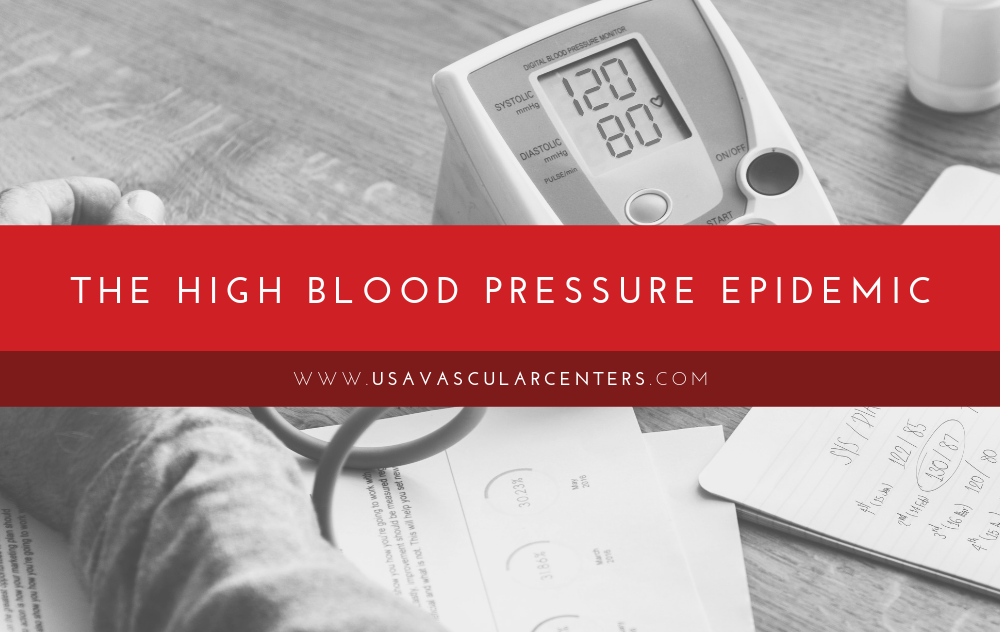Did you know that one in three adults – or about 103 million people in the United States – have high blood pressure? That’s nearly a third of the U.S. population, and it’s more common than other conditions like cancer, which occurs in one in four adults.
High blood pressure, also known as hypertension, occurs when you have levels 130 over 80 millimeters of mercury (mmHg). Hypertension is when the long-term force of the blood pushing against your arterial walls is high enough that it may cause serious health conditions.
To understand blood pressure a little more thoroughly, it’s important to know that there are two types of blood pressure:
- Systolic refers to the pressure inside your arteries when your heart is pumping
- Diastolic is the pressure inside your arteries when your heart is resting between the beats
High blood pressure is a progressive condition that worsens without lifestyle changes. Unmanaged hypertension can lead to heart attacks, strokes, or vascular diseases such as coronary artery disease and peripheral artery disease (PAD).
Unfortunately, both vascular disease and stroke are currently the leading causes of death in the United States.
How to Know You Have High Blood Pressure
High blood pressure can present itself in different ways, depending on your age, gender, and the cause of the high blood pressure. While high blood pressure typically does not present any overt symptoms, signs of worsening and untreated high blood pressure can include headaches, fatigue or confusion, vision problems, and even nosebleeds.
Risk Factors
Why you have high blood pressure is based on your individual situation. There are many lifestyle, environmental, hereditary, or physical risk factors that can increase your risk of developing high blood pressure. Some of the most notable are smoking, eating a high-sodium diet, stress, high cholesterol, and a lack of physical activity.
Measuring High Blood Pressure
Your blood pressure levels are determined by the amount of blood your heart pumps and by the amount of resistance to blood flow within your arteries. Over the years, the more blood your heart has to pump through your body, the narrower your arteries will become and the higher your blood pressure levels will be.
A doctor measures your blood pressure by using an inflatable cuff wrapped around your arm. The gauge on the cuff will measure your blood pressure and inform the doctor where your levels are at. Then, the cuff will inflate slowly so that it feels snug on your arm. The cuff will let out air slowly decreasing this pressure while the doctor listens to your pulse with a stethoscope watching the gauge. This entire process takes five minutes or less.
If you are over the age of 40, you should be getting a routine blood pressure check at your annual physical. If you are at an increased risk due to the risk factors above, you may need to have a blood pressure exam more frequently.
Peripheral Artery Disease and High Blood Pressure
A major risk factor for peripheral artery disease (PAD) is high blood pressure. High blood pressure allows plaque to build up more easily. PAD is when your arteries become either partially or fully blocked by plaque buildup.
When your arteries are healthy and dilated, blood can flow easily and your heart doesn’t have to work as hard; however, when your arteries are narrow, your blood pressure rises, the heart gets stressed from pumping harder, and arteries can become damaged. If high blood pressure and plaque buildup are both stressing your arteries, this can become life-threatening.
Managing high blood pressure and peripheral artery disease is important. A vascular specialist can recommend helpful lifestyle changes, as well as procedures such as stent angioplasty which can open blocked arteries and promote healthy blood flow.
What Can Help High Blood Pressure
Lifestyle modifications are the first step you should take toward lowering your blood pressure and decreasing your chances of developing more severe vascular issues. A few habits you can adopt include:
- Exercising regularly
- Eating a healthy diet
- Reducing your cholesterol
- Quitting smoking
- Reducing alcohol consumption
- Decreasing daily causes of stress
- Monitoring your blood pressure at home
Treatment for Peripheral Artery Disease
If you think you may have PAD and you have high blood pressure, it may be time to seek out treatment. USA Vascular Centers specializes in the non-surgical, outpatient treatment of PAD. Don’t wait until your symptoms get worse, schedule an initial consultation with a vascular specialist today, or call us at 888-773-2193 to learn more.


